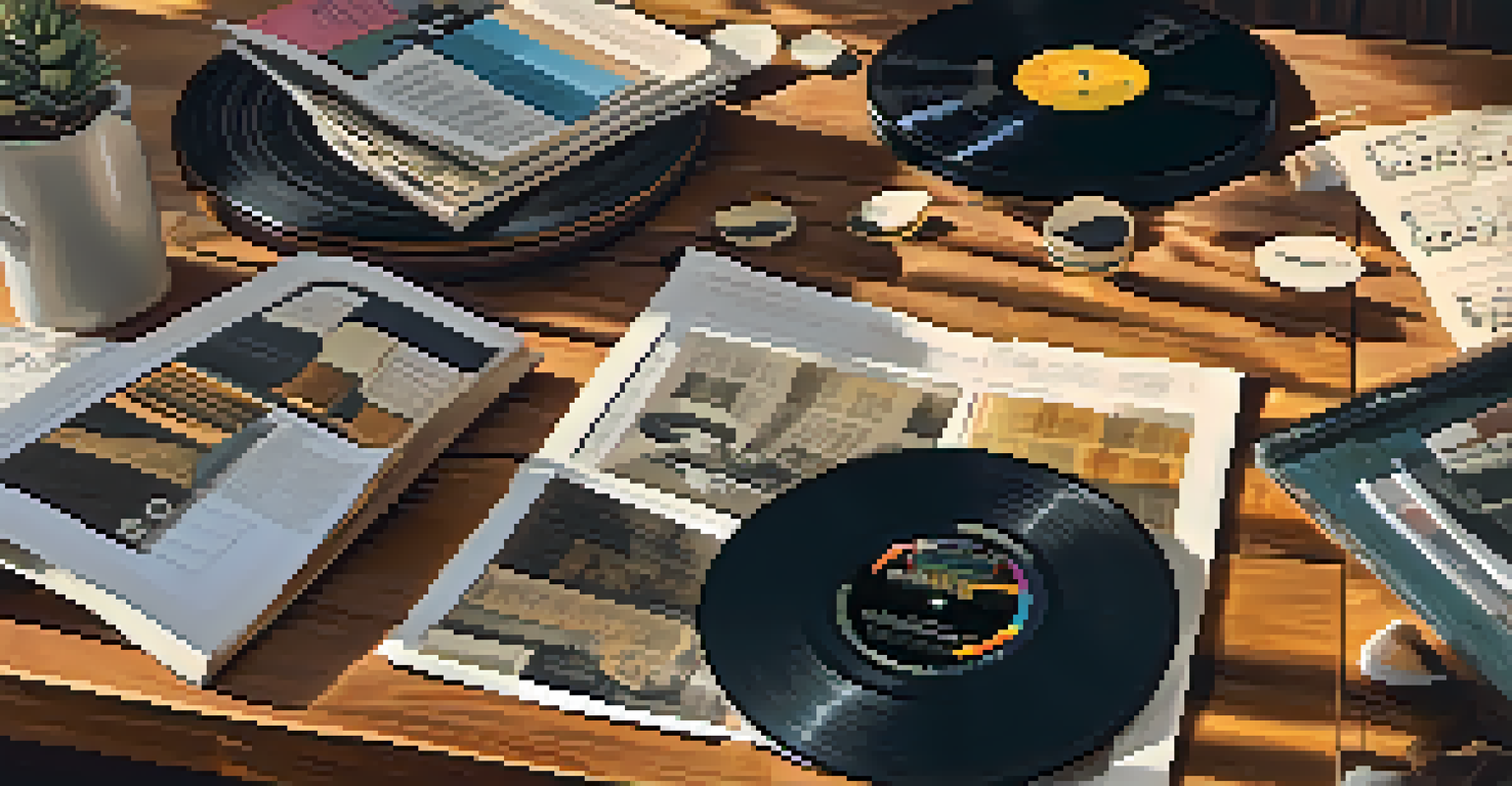Building a Portfolio: Essential for Aspiring Film Composers

Why a Portfolio is Crucial for Film Composers
A portfolio serves as your calling card in the film industry. It's not just a collection of your work; it represents your unique voice and style as a composer. In a competitive field, having a well-curated portfolio can set you apart from others vying for the same opportunities.
A portfolio is not just a collection of your work; it is a reflection of who you are as an artist.
Think of your portfolio as a showcase of your best pieces, much like an artist displays their finest paintings in a gallery. It allows potential clients or collaborators to quickly assess your skills and see how your music can enhance their projects. Without a portfolio, your talent might go unnoticed in the vast sea of creative professionals.
Moreover, a robust portfolio can open doors to networking opportunities. When you meet directors, producers, or fellow composers, being able to present your work confidently can lead to collaborations and exciting projects down the line.
Choosing the Right Pieces for Your Portfolio
Selecting the right pieces is vital to crafting a compelling portfolio. Aim for a mix of works that highlight your versatility but also reflect your personal style. Including various genres and formats, such as film scores, short films, and even personal projects, can showcase your range and adaptability.

Consider the emotional impact of each piece you choose. A powerful score can evoke feelings and tell a story, making it more memorable for your audience. It's essential to not only pick pieces that sound good but also those that resonate with the viewer, demonstrating your ability to connect emotionally through music.
A Portfolio Showcases Your Voice
Your portfolio is a vital tool that highlights your unique style and skills, setting you apart in the competitive film industry.
Lastly, don’t shy away from including pieces that may not be perfect. Sometimes, works that exhibit growth or experimentation can provide insight into your journey as a composer. This authenticity can be appealing to those looking to collaborate, as it shows your willingness to evolve and take creative risks.
Creating a User-Friendly Online Portfolio
In today’s digital age, having an online portfolio is essential for accessibility. A well-designed website can make it easy for potential clients to navigate through your work without frustration. Ensure that the layout is clean and intuitive, allowing visitors to focus on your music rather than getting lost in complicated menus.
The best way to predict the future is to create it.
Consider using platforms like SoundCloud or Vimeo to host your audio and visual pieces. Linking to these platforms from your website can streamline the experience, providing quick access to your work. Additionally, embedding audio clips directly can allow visitors to listen without leaving your site, encouraging them to explore more.
Don’t forget to optimize your portfolio for mobile devices. Many people browse on their phones, and ensuring your site is responsive can significantly expand your reach. A seamless user experience on all devices can make a lasting impression and keep potential collaborators engaged.
Writing Engaging Descriptions for Your Work
Descriptions provide context for your pieces, helping viewers understand your creative process and intention. Instead of simply naming a track, share the story behind it and what inspired you. This narrative can draw people in and make them more invested in your work.
Consider using a conversational tone in your descriptions. This approach can create a more relatable connection with your audience, making them feel like they know the composer behind the music. Engaging descriptions can turn a simple listen into a memorable experience, sparking interest in your other works.
Choose Pieces Wisely for Impact
Selecting a diverse mix of works that resonate emotionally can effectively showcase your versatility and personal growth as a composer.
Additionally, don't hesitate to highlight any notable collaborations or projects related to each piece. If you worked with a well-known director or on a successful film, mentioning this can add credibility and intrigue to your portfolio, showcasing your ability to work within the industry.
Incorporating Testimonials and Recommendations
Testimonials from directors, producers, or collaborators can enhance your portfolio by providing social proof of your skills. These endorsements can speak volumes about your professionalism and the quality of your work. Including a few well-placed quotes can elevate your portfolio and give potential clients confidence in your abilities.
When asking for testimonials, consider reaching out to individuals you've worked closely with, as their insights will carry more weight. A personal touch in these endorsements can make them feel more genuine and relatable. If appropriate, include a photo of the person giving the testimonial alongside their words for added authenticity.
Additionally, displaying any awards or recognitions you've received can further strengthen your portfolio's impact. These accolades can serve as a testament to your talent and dedication, making it easier for others to see your potential as a film composer.
Keeping Your Portfolio Updated and Fresh
As you grow and evolve as a composer, it's essential to keep your portfolio updated with your latest work. Regularly adding new projects can reflect your growth and keep your portfolio dynamic. This practice not only showcases your current skills but also keeps viewers coming back to see what’s new.
Set a routine for reviewing and refreshing your portfolio. This could be monthly or quarterly—whatever works for you. During these reviews, consider removing older pieces that no longer represent your capabilities or style, allowing space for new, more relevant work.
Regular Updates Keep It Relevant
Consistently refreshing your portfolio with new projects and revisiting older works reflects your evolution and keeps your audience engaged.
Moreover, updating your portfolio can also involve revisiting older pieces and reworking them. You might find that with your newfound skills, you can enhance previous compositions, turning them into showcase-worthy pieces that reflect your growth as an artist.
Promoting Your Portfolio Effectively
Once your portfolio is polished and ready, it's time to promote it. Utilize social media platforms to share snippets of your work and link back to your portfolio. Engaging with communities on platforms like Instagram, LinkedIn, or Twitter can help you reach a wider audience and connect with others in the industry.
Consider joining online forums and groups specifically for film composers and creators. Sharing your portfolio in these spaces can lead to valuable feedback and potential collaborations. Networking in these communities can also help you stay informed about industry trends and opportunities.

Lastly, don't underestimate the power of word-of-mouth. Tell friends, family, and colleagues about your work, and encourage them to share your portfolio with their networks. Personal recommendations can be incredibly effective in reaching new clients and collaborators.